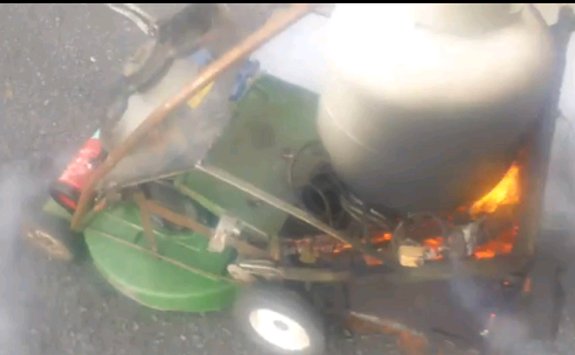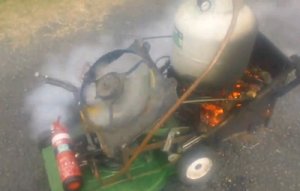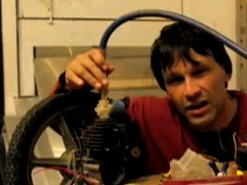
Steam powered lawn mower and harvesting compressed air


Have you ever wondered if it was possible to convert a lawn mower to
run on steam power?
I'm not sure how safe it is,
but I love the ingenuity of this project by Youtube user dsquad.

GreenPowerScience has a
neat video on how to take an old weed eater engine and convert it to
run on compressed air with the addition
of a well placed reed switch. This seems like a safer alternative to
steam power. It might be possible to build a contraption that powers a
small generator if one could somehow harvest compressed air.
Want more in-depth information? Browse through our books.
Or explore more posts by date or by subject.
About us: Anna Hess and Mark Hamilton spent over a decade living self-sufficiently in the mountains of Virginia before moving north to start over from scratch in the foothills of Ohio. They've experimented with permaculture, no-till gardening, trailersteading, home-based microbusinesses and much more, writing about their adventures in both blogs and books.
Want to be notified when new comments are posted on this page? Click on the RSS button after you add a comment to subscribe to the comment feed, or simply check the box beside "email replies to me" while writing your comment.

When using this steam powered lawn mower it may be best to mow the outer perimeter of the lawn first. That way you when the center section of the lawn bursts into flames, you have already created the necessary firebreak.
...lol I shouldn't be like that, I actually love this kind of stuff. Now I wanna make one, but it needs to be a rider. Thanks for posting it Mark
I was thinking like you Justin.....should have been a riding version....might be real nice in the winter...although one usually doesn't need to mow the grass then....but it would be fun and hot at the same time.
We like to go with saftey first around here and such a basic steam powered gizmo would surely fail over time and really hurt someone if it were to explode.
That being said we are also often looking for ways to generate power without using electricity...like the compressed air engine. I once lived next door to a guy who had this idea to make a huge device that used the weight of a passing car to compress a little bit of air at a time.....somehow implant a pump like device into the road and have the air go through a valve system....have it right in front of your house and harvest power when people drive by. Not sure if it's feasable, but have never forgoten that concept.
Yep, you convinced me that I need a steam powered riding snowblower.I don't want to start thinking about snow already though.
I have read about a few steam powered generators. I recall a couple that were very well built. With some sort of preassure relief valve added into the system I don't think they should be any more dangerous than a pressure canner or a water heater.
I have an older magazine around here that had a steam power article in it. If I recall correctly it had addresses for a couple of people selling steam engine parts or plans or something. I will find it one of these days and see what's in it.
Mark, compressed air is a terribly inefficient energy carrier. You'll need 7-8 hp of electricity to make 1 hp of air power using a modern compressor. (1)
A steam engine's efficiency is limited by the temperatures the materials can withstand. An engine venting the steam in the air will be only 1-10% efficient. Adding a condensor can improve this to 25% (and minimizes the amount of scalding hot steam flying around). Only a steam turbine with re-heater, economizer and water cooling as used in power stations can approach 50%.
If you want to make an environmently friendly steam engine, you'd have do two things;
If you can grow your own fuel, efficiency might not be on the top of your mental list but you'll still want to minimize your wood use to prevent pollution and to not outgrow the replenishment rate of your woodland. The "fire under an old propane tank" boiler design isn't a very good one in that respect, to say the least! And yes, a safety valve is essential.
But it is possible to make a steam-driven vehicle yourself, see e.g. the hudspith steam bicycle.
Justin; there are tons of (small) steam engine plans available on the internet. But to build one you'll need access to a machine shop.
Making a safe boiler seems the biggest challenge to me. Superheated steam is very dangerous if it gets released instantaneously because of a boiler failure. When a reasonable size boiler blows when you're standing next to it you'd be cooked before you could blink with your eyes! Look e.g. at the Mythbusters video of an exploding water heater
There is probably more than one reason. Some that I can think of;
The first real steam piston engines were built approximately 200 years ago! They are completely mechanically controlled devices.
Early problems with boiler explosions were often due to material and processing faults and lack of knowledge.
I'm pretty sure a mower with a steam engine isn't patentable. For one, a powered mower needs an engine. That you could use a steam engine would be pretty 'obvious to anyone versed in the art'. Second, the referenced pictures would constitute prior art.
Nor is it a very good idea.
Even if you get your energy from locally sourced wood, you wouldn't want to waste it (it takes time and nutrients and sunshine to re-grow the wood and effort to cut and dry it). And a simple steam engine without a condenser and with an open boiler is pretty inefficient. You'd be lucky to get 10% of the energy of the wood converted into mechanical energy, and it could be as low as 1%.
Additionally, steam engines do not only use fuel, they also use water. And quite a lot of it. Unless you want to carry a large water tank or a condensor, youd have to replenish the boiler quite frequently.
Have you ever seen a steam engine starting up (even a toy one)? You have to fill the boiler with water, clean out the ash trap, add new fuel, light a fire and wait for the pressure to rise. That's quite a chore if all you want to do is mow the lawn. Besides you'd have to tend the file and refill the boiler while mowing.
If you want to know more, study e.g. why the steam car lost to the car with internal combustion engines. The article on advanced steam technology is also illustrative.
Steam can be a very good way to convert thermal energy into mechanical energy, if it is done properly. Most of todays power stations use steam turbines to drive their generators because of their thermal efficiency (using the Rankine cycle), simplicity and the excellent power/weight ratio of turbines.